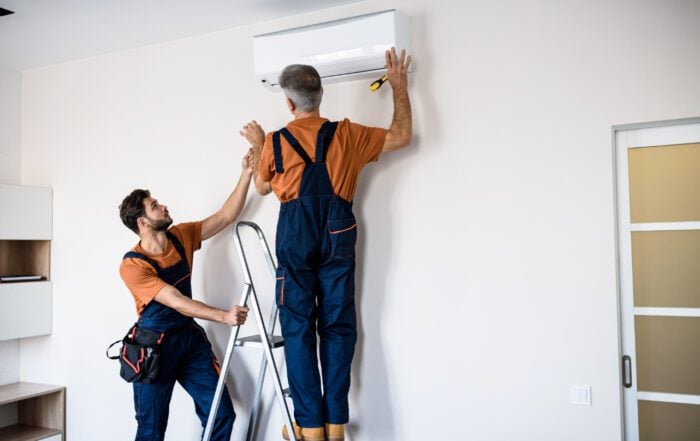Summer heat is quickly approaching, and that means you’re preparing to turn on your air conditioning.
For many people, window units have been an easy solution. They’re easy to install, they’re inexpensive, and they can be used in just about any space. But sometimes they’re just not enough. Window units do nothing to help with filtration for those with allergies, and they don’t circulate the air as well in a room, leaving you with hot and cold spots. Then there’s the issue of having to purchase and operate a unit for every room in your home. And what about interior rooms like bathrooms that don’t have windows?
So if you’re looking to make the switch, you have a few different options, the most common being central air conditioning or ductless mini-splits.
Benefits of Central Air Conditioning
Switching to central A/C can be a big commitment, but there are many advantages that come with it.
Cleaner Air
Unlike window units, central air conditioning systems use filters to improve your IAQ (indoor air quality). If you suffer from allergies, this option will help you eliminate pollen and dust from your home.
Effective Circulation
While window units can leave you with hot and cold spots around the room, you’re less likely to have that issue with this type of system as it more effectively circulates air.
Reduced Noise
If you already have a window unit, you know how noisy they can be. With a central system, that won’t be an issue. The only part of the unit that makes much noise is the outdoor unit.
More Space
Because the main unit is outside, it creates more space inside the home. That also means no unsightly pieces taking away from any aesthetics.
Easy to Use
You can operate the entire air conditioning system from a single thermostat. With window units, you have to change the settings on each one.
Multiple Functions
Some units can double as both a cooling and a heating system. And these multi-systems can save even more space.
Benefits of Ductless Mini-Splits
Ductless mini-splits are comparable to central systems as they do the same job, but they do that job in different ways. So some of the benefits are a little different.
Small Size
The main advantage of a ductless mini-split system is their size. Multiple indoor units can connect to one outdoor unit, the number of units depending on the size of the home or building.
Most indoor units you’ll come across are approximately 7” deep and come with a modern, sleek jacket – so unlike those window units, the mini-splits won’t be an eyesore for your family and guests.
Creates Zones
Each of these small units or zones will be controlled by its own thermostat, making the system much like a combination of window units and central A/C, but without the unsightliness of the window units. Zoning a system in this way allows you to condition the space only when you need to, which means the energy savings will add up.
Easy Installation
A major benefit of a ductless air conditioning system is that they’re easier to install than central systems. The hookup from the outside unit to the inside zones usually only requires a small hole through the wall. And since most manufacturers have varying lengths of conduit available for the connection, placement for the outdoor unit is little to no issue.
Less Energy Loss
Because mini-splits don’t require ductwork, they don’t have the same level of energy loss that central systems do. Ductwork is responsible for about 30% of energy consumption when conditioning a space. Even more so if the ductwork runs through an unconditioned space like a basement or attic.
Flexibility
Ductless mini-splits offer more design options than other add-on systems. You can place the indoor units almost anywhere in the home: suspended from the ceiling, flush into a drop ceiling, or even placed on a wall. And with some models, you may also have the option of a floor-standing unit.
Since you have the option of mounting the indoor unit out of reach, many models also include a remote control so you can easily turn the system on or off.
Heating and Cooling
Like the specific central units we mentioned above, mini-splits can both heat and cool, depending on the style and model you choose.
Safety
Because you only need a small hole in the outside wall, this type of air conditioning system provides an added level of safety. Window units on lower level floors prove to be easy access to your home for criminals.
Energy Savings
And because EnergyStar certified systems are available for rebates from some local utilities, you can start putting money back in your pocket right away.
Air Conditioning Systems: the Cons
With all of the pluses between these two systems, there are still going to be a few negatives.
Central Air Conditioning Systems
Cost
Central A/C is designed to cover the entirety of the home, not just individual rooms. So the operating cost can also be much higher than a window unit or mini-split as it requires much more energy.
And because central systems cover the whole home, doors could be a hindrance. When doors stay closed, the system will have difficulty being efficient as it needs to flow through the entire house.
All or Nothing
As a central air conditioning system is designed to adjust the air throughout the entire home, it’s going to keep working until it reaches the correct temperature. And that means the whole home needs to be sealed off. If you leave a window open somewhere, the hot outside air can rapidly get it and undo much of its work. And that means your system will keep running to fix it, driving up your energy costs.
Of course, we have quite a few helpful energy-saving tips to help make these problems less of an issue for you.
Ductless Mini-Spit Negatives
Cost
Cost is the number one downside to a mini-split system. The cost is relative to the model’s cooling capacity and can be about 30% more than a central air conditioning system (minus the ductwork). And that means they may cost twice as much as your window unit.
Installation
It’s very important that the installer properly sizes each indoor unit as well as places it correctly.
If it is oversized or misplaced, the system could short-cycle – and that means a waste of energy as well as poor temperature and humidity control.
You also have the negative side effect of spending too much up front and over time if your system is larger than it needs to be.
Appearance
While most models have more modern-looking indoor units, some people still may not care for the look of the system. They’re less noticeable than a window unit, but still not as much as a central system.
Finding the Right Installer
Qualified service professionals are often difficult to find. But lucky for you, Stack Heating, Cooling, Plumbing & Electric is one of those professionals.
With all of this information now in your hands, we’re sure you have a lot to think about. But when you land on a decision, or if you need some expert input, Stack Heating, Cooling, Plumbing & Electric is here to help. We provide installation services for both central air conditioning and ductless mini-split systems, so no matter your decision, we can lend a hand to get you and your family comfortable now.
Have Any Questions?
If this is an emergency please call 440-937-9134.
Otherwise, please feel free to call us or submit this form to schedule an appointment for service or request an estimate. We will contact you shortly!



